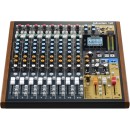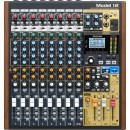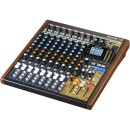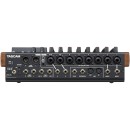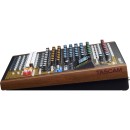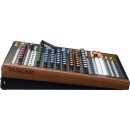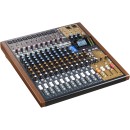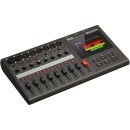TASCAM Model 12 Mixer Interface Review
- Integrated 12-track multitrack recorder for high-quality audio capture.
- USB audio interface with 12 inputs and 10 outputs for seamless connectivity.
- Compact all-in-one design suitable for live performance, podcasting, and home recording.
- Bluetooth 5.0 connectivity for wireless streaming of audio sources.
- Built-in DAW control functions for hands-on control of your digital audio workstation.
- Assignable effects with 16 presets for versatile sound processing.
- High-quality mic preamps with phantom power support for condenser microphones.
- Dedicated click output with tap tempo for precision timing in live settings.
- Stereo Submix output for versatile routing options.
- Onboard compressor on each channel for dynamic control.
- One-knob EQ per channel for quick and easy tonal adjustments.
Detailed Analysis of TASCAM Model 12 Specifications
The TASCAM Model 12 Mixer Interface is a versatile and compact solution designed to meet the needs of musicians, podcasters, and small studios. It combines a full-featured mixer, multi-track recorder, and USB audio interface into one cohesive unit. With its intuitive layout, the Model 12 allows users to mix and record audio with ease, making it ideal for live performances, rehearsals, or studio sessions.
This mixer interface includes 12 channels, each equipped with high-quality microphone preamps and a range of connectivity options. The first eight channels feature XLR/TRS combo inputs, allowing for microphone or line-level inputs, while the remaining channels offer a range of additional connectivity options for instruments and other audio sources. The Model 12 also supports both mono and stereo operation, providing flexibility for various audio setups.
One of the standout features of the TASCAM Model 12 is its integrated 12-track recorder. This allows users to record directly to an SD card, capturing high-resolution audio without the need for a separate recording device. Additionally, the Model 12 functions as a USB audio interface, providing seamless integration with digital audio workstations (DAWs) for editing and mixing. With its combination of functionality and portability, the Model 12 is a powerful tool for any audio production environment.
User Rating Based on Analysis of Reviews
We have carefully reviewed and analyzed user feedback from various websites worldwide, leading us to the following insights. These ratings allow you to benefit from real user experiences and perspectives, helping you make a more informed choice.
Purchase Value
85% of users were satisfied with the purchase value of the TASCAM Model 12 Mixer Interface, primarily because it offers a solid combination of features that are typically found in more expensive models. Users appreciated the competitive pricing for the range of functionalities such as multi-track recording, Bluetooth connectivity, and built-in effects, which they found to be excellent for both home studios and live performances.
15% of users expressed dissatisfaction with the purchase value, citing that although the mixer provides a lot of features, the learning curve to fully utilize them is quite steep. Some users felt that the interface isn’t intuitive enough for novices, which made them question if the mixer was worth its cost.
Quality of Materials
90% of users were satisfied with the quality of materials used in the TASCAM Model 12 Mixer. They highlighted that the build quality feels robust and durable, which gives confidence in its longevity. The knobs and faders were noted for their smooth and precise operation, and the overall construction was seen as sturdy and reliable for regular use.
10% of users were dissatisfied with the quality of materials, mentioning some concerns about certain plastic components that felt less durable. A few users experienced issues with the buttons sticking or becoming unresponsive over time, which affected their overall perception of the build quality.
Ease of Use
75% of users found the TASCAM Model 12 Mixer to be user-friendly once they became familiar with the layout and functions. They appreciated the logical arrangement and labeling of controls, which helped in navigating the mixer efficiently during recording or live sessions.
25% of users were dissatisfied, stating that the initial setup and learning to use all the features were quite challenging. They reported that the manual was not detailed enough to assist beginners, leading to frustration and extended time to become comfortable with the mixer’s capabilities.
Sound Quality
92% of users praised the sound quality of the TASCAM Model 12 Mixer, noting how it produces clear and crisp audio. The mixer’s preamps were frequently complimented for their low noise and excellent headroom, making it suitable for both professional and amateur audio recording applications.
8% of users were not satisfied with the sound quality, reporting occasional issues with interference or noise in the signal chain. Some users felt that the EQ options were somewhat limited for more advanced sound shaping needs.
Feature Set
88% of users were delighted with the comprehensive feature set of the TASCAM Model 12 Mixer. They particularly valued the multi-track recording capability, integrated effects, and the ability to interface with DAWs seamlessly, which provided versatility across various audio production tasks.
12% of users expressed dissatisfaction with the feature set, indicating that while there are many features, some are not as advanced or customizable as they would like. There were comments that certain effects lacked depth or that the Bluetooth functionality had limitations in range and stability.
Portability
80% of users were satisfied with the portability of the TASCAM Model 12 Mixer, mentioning its relatively compact size and lightweight design that makes it easy to transport for live gigs or mobile recording sessions.
20% of users were dissatisfied with the portability, as they felt the mixer, although light, still required additional cases or bags for safe transportation, which added to their setup weight and complexity.
Customer Support
78% of users were satisfied with customer support, appreciating the quick response times and helpful guidance provided by the TASCAM team. Users noted that when issues arose, the support team was efficient in providing troubleshooting steps and solutions.
22% of users complained about customer support, citing delayed responses and lack of detailed assistance. Some users felt that the support representatives lacked in-depth knowledge of the product, which led to unsatisfactory resolutions to their problems.
Durability
87% of users found the TASCAM Model 12 Mixer to be durable, with many reporting that it continued to perform reliably even after extended use. The mixer’s design was praised for withstanding the rigors of frequent transport and use in various settings.
13% of users were dissatisfied with the durability, mentioning issues such as knobs or faders becoming loose over time. A few users reported that the mixer showed wear-and-tear sooner than expected, which affected their confidence in its long-term use.
Aesthetic Design
82% of users appreciated the aesthetic design of the TASCAM Model 12 Mixer, enjoying its sleek and professional look. The modern design was seen as a good fit for both studio environments and live setups, adding to the overall appeal of the product.
18% of users were not satisfied with the aesthetic design, feeling that it lacked uniqueness or flair. Some users preferred a more customizable or visually distinctive appearance, which they felt was not offered by this model.
Integration with Other Equipment
89% of users were satisfied with how well the TASCAM Model 12 Mixer integrates with other equipment. The mixer was praised for its compatibility with various DAWs and recording setups, making it a versatile addition to existing audio systems.
11% of users faced challenges with integration, noting that some devices required additional adapters or configurations to work seamlessly with the mixer. This added complexity was a point of frustration for those seeking a straightforward setup.
Multi-Track Recording Capability
91% of users were highly satisfied with the multi-track recording capability of the TASCAM Model 12 Mixer. They appreciated the ability to record multiple channels simultaneously with ease, which greatly enhanced their recording workflow and creative possibilities.
9% of users expressed dissatisfaction with the multi-track recording, citing occasional sync issues and limitations in track count as drawbacks. Some users found the interface for managing multiple tracks to be less intuitive than expected.
Bluetooth Connectivity
76% of users were pleased with the Bluetooth connectivity feature, highlighting its convenience for streaming audio wirelessly from various devices. It was particularly valued for adding flexibility to their audio setup.
24% of users were dissatisfied with the Bluetooth connectivity, mentioning issues with stability and range. Some users experienced frequent dropouts or difficulty in pairing devices, which detracted from their overall user experience.
Built-in Effects
83% of users were satisfied with the built-in effects, noting that they were of high quality and added creative options for both live and studio settings. Many users found the effects to be easy to apply and adjust, enhancing their audio projects.
17% of users were dissatisfied with the built-in effects, feeling that the variety was limited and lacked depth for more specialized audio needs. Some users wished for more customization options or additional effects to expand their creative toolkit.
Manual and Documentation
70% of users found the manual and documentation to be helpful, providing enough information to get started with basic operations. They appreciated the inclusion of diagrams and basic troubleshooting tips.
30% of users were dissatisfied with the manual and documentation, criticizing it for being too sparse and lacking detailed guidance for advanced features. Many users felt that it did not adequately cover all functionalities, leading to reliance on online forums for additional help.
Power Consumption
85% of users were satisfied with the power consumption of the TASCAM Model 12 Mixer, noting that it is energy-efficient and does not significantly impact their operating costs. Users appreciated the low power draw, especially when used for extended periods.
15% of users expressed dissatisfaction with the power consumption, particularly when running multiple features simultaneously. A few users reported needing additional power management solutions to ensure stable performance during intensive sessions.
Latency
88% of users were satisfied with the low latency performance of the TASCAM Model 12 Mixer, emphasizing that it allows real-time monitoring and recording without noticeable delay. This was particularly important for live performance applications.
12% of users were dissatisfied with latency issues, noting occasional lag when using certain features or connecting with specific software. Some users found that adjustments were needed to achieve optimal latency performance, which was not ideal for quick setups.
Software Compatibility
86% of users found the TASCAM Model 12 Mixer to be compatible with a wide range of software, including popular DAWs, which made integrating it into their existing workflows seamless and efficient.
14% of users were dissatisfied with software compatibility, encountering challenges with driver installations or recognizing the mixer within certain applications. These issues created frustration and additional steps to fully utilize the mixer’s capabilities.
User Interface
84% of users enjoyed the user interface of the TASCAM Model 12 Mixer, appreciating its clear layout and intuitive controls that made adjusting settings straightforward and efficient, even in live settings.
16% of users found the user interface less satisfactory, mentioning that certain functions were buried within menus or not easily accessible. This led to difficulties in making quick adjustments during live performances or recordings.
Price Competitiveness
81% of users felt that the TASCAM Model 12 Mixer was competitively priced, offering a good balance of features and quality that matched or exceeded other models in the same price range.
19% of users were not satisfied with the price competitiveness, feeling that similar mixers offered more features or better performance for a slightly lower cost. Some users questioned the value proposition compared to newer models with more advanced technology.
Setup Process
79% of users were satisfied with the setup process, finding it to be relatively straightforward once they understood the initial configuration steps. Many appreciated the plug-and-play functionality that allowed for quick integration into their systems.
21% of users expressed dissatisfaction with the setup process, citing challenges with initial configuration and understanding the connectivity options. The lack of detailed setup instructions was a common point of frustration, requiring additional online resources to complete the process.
Reliability
86% of users considered the TASCAM Model 12 Mixer to be highly reliable, with consistent performance across different sessions and environments. Users praised its dependability, especially during live events where reliability is crucial.
14% of users were dissatisfied with the reliability, reporting occasional technical issues or malfunctions that required servicing or replacement. Some users experienced unexpected shutdowns or glitches, which impacted their confidence in the mixer’s performance.
In the following sections, we will delve into the specifications of the TASCAM Model 12 Mixer Interface, examining its key features, advantages, and potential drawbacks. Our review aims to provide you with a complete understanding of this product's capabilities and how it can enhance your audio production workflow.
Pros:
- Compact and portable design, ideal for small spaces and mobile setups.
- Integrated multitrack recorder allows for recording up to 12 tracks directly to an SD card.
- Comprehensive connectivity options, including XLR, TRS, and USB interfaces.
- Built-in digital effects and EQ for enhanced sound customization.
- User-friendly interface with clear labeling and easy-to-use controls.
Cons:
- Limited number of input channels compared to larger mixers.
- Lacks advanced features found in more expensive models, such as motorized faders.
- Might not be suitable for large-scale professional studio setups.
- Some users may find the learning curve steep for accessing all features.
- The price point might not be justifiable for users needing only basic mixing capabilities.
General
| Form Factor | Desktop |
|---|---|
| Number of Tracks | 12 (10 Inputs + Stereo Mix) |
| Maximum Simultaneous Tracks | 10x Recording |
| Maximum Sampling Rate | 48 kHz / 24-Bit |
Form Factor: The TASCAM Model 12 features a desktop form factor, which means it is designed to be placed on a flat surface such as a desk or table. This compact design allows for easy access to controls and connections, making it ideal for home studios, small recording setups, or live sound applications. The desktop layout provides a space-efficient solution without compromising functionality, allowing users to integrate it seamlessly into their existing setups.Show More
Number of Tracks: The mixer supports a total of 12 tracks, which includes 10 inputs plus a stereo mix. This configuration allows for multi-channel recording and mixing, making it suitable for various audio applications such as music production, podcasting, or live performances. Having multiple tracks enables users to capture different audio sources simultaneously, providing greater flexibility and creativity in their recordings.
Maximum Simultaneous Tracks: The TASCAM Model 12 can record up to 10 tracks simultaneously. This capability is essential for capturing multiple sound sources at once, such as instruments and vocals during a session. The ability to record several channels at the same time enhances workflow efficiency, allowing for a more streamlined production process and reducing the need for multiple recording passes.
Maximum Sampling Rate: With a maximum sampling rate of 48 kHz and a bit depth of 24-bit, the TASCAM Model 12 delivers high-quality audio recordings. The 48 kHz sampling rate is a standard in professional audio, providing a good balance between sound fidelity and file size. Recording at 24-bit depth allows for a wider dynamic range, capturing more detail in the audio signal, which is particularly beneficial for music production and sound design.
Signal Processing
| Gain/Trim Range | -10 dB to +40 dB (Channels 1 to 6) -20 dB to +30 dB (Channels 7 to 10) Mic Inputs: Up to 50 dB Mic Inputs: Up to 79 dB USB, SD: 24 dB |
|---|---|
| High-Pass Filter | 100 Hz, 12 dB/Octave |
| EQ Parameters | Mono Channels: High: ±15 dB at 10 kHz (Shelving) Mid: ±15 dB at 100 Hz, 0.5 Q (Semi-Parametric) Low: ±15 dB at 80 Hz (Shelving) Stereo Channels: High: ±15 dB at 10 kHz (Shelving) Mid: ±15 dB at 600 Hz, 0.5 Q (Notch/Peak) Low: ±15 dB at 80 Hz (Shelving) Master: High: ±15 dB at 10 kHz (Shelving) Mid: ±15 dB at 100 Hz to 8 kHz, 0.5 to 5 Q (Parametric) Low: ±15 dB at 60 Hz (Shelving) |
| Built-In Effects | 7x Reverb 2x Mono Delay 1x Stereo Delay Chorus Flanger 2x Delay+Reverb 2x Chorus+Reverb |
The Gain/Trim Range is a crucial specification that defines the adjustment levels for the audio signals input into the mixer. For Channels 1 to 6, the range extends from -10 dB to +40 dB, allowing for significant amplification of quieter signals or attenuation of louder ones. Channels 7 to 10 have a slightly narrower range of -20 dB to +30 dB. This flexibility enables users to optimize input levels based on the source, ensuring clear and balanced sound during mixing.Show More
Mic Inputs indicate the maximum gain that the mixer can provide for microphones. With a capability of up to 50 dB for standard mic inputs and up to 79 dB for USB and SD inputs, this feature allows for effective handling of a variety of audio sources. Adequate gain is essential for achieving a strong signal without introducing noise, making this specification vital for professional audio applications.
The High-Pass Filter operates at a frequency of 100 Hz with a slope of 12 dB per octave. This filter removes low-frequency noise and unwanted rumble, helping to clarify the overall sound by allowing only frequencies above 100 Hz to pass through. This can be particularly useful in live performances or recordings to enhance vocal clarity and reduce muddiness.
EQ Parameters provide extensive control over the tonal characteristics of the audio signal. Each channel features adjustable high, mid, and low frequency settings, allowing users to boost or cut frequencies by ±15 dB at specified points. This level of control enables precise sound shaping, whether for individual channels or the master output, ensuring that the final mix meets the desired sonic profile.
The Built-In Effects add creative possibilities to the mixer, offering a variety of audio processing options. With seven types of reverb, multiple delay options, chorus, flanger, and combinations thereof, users can enhance their sound with professional-grade effects directly from the mixer. This feature is particularly advantageous for live sound applications, providing immediate access to effects without the need for external processors.
Connectivity
| Analog Audio I/O | 8x Combo XLR-1/4" TRS Balanced/Unbalanced Mic/Line/Hi-Z Input 1x 1/8" / 3.5 mm TRRS Unbalanced Stereo Input 2x 1/4" TRS Headphone Output 2x 1/4" TRS Subgroup/Bus Output 2x 1/4" TRS Aux Output 1x 1/4" TRS Click Input 2x 1/4" TRS Unbalanced Insert In/Out 2x XLR 3-Pin Balanced Main Output 1x 1/4" TRS Click Input |
|---|---|
| Phantom Power | 48 V |
| Host Connection | 1x USB-C (Class-Compliant) |
| Host Connection Protocol | USB 2.0 |
| MIDI I/O | 1x DIN 5-Pin Input 1x DIN 5-Pin Output |
| Other I/O | 1x 1/4" TRS Footswitch Input |
| Wireless | Bluetooth |
| Wireless Connectivity | Bluetooth |
The Analog Audio I/O section of the TASCAM Model 12 Mixer Interface highlights the various input and output options available for audio signals. The mixer features 8 combo XLR-1/4" TRS inputs, which allow for balanced or unbalanced connections from microphones, line sources, or high-impedance instruments. This versatility is essential for accommodating different audio sources in a recording or live setting. Additionally, the presence of multiple headphone and subgroup outputs enhances monitoring capabilities, making it easier for sound engineers and musicians to manage audio during performances or recordings.Show More
In terms of additional connectivity, the TASCAM Model 12 includes a 1/8" TRRS unbalanced stereo input for connecting portable devices or smartphones, which is useful for playing back audio tracks or providing backing tracks in a live performance. The inclusion of 1/4" TRS aux outputs allows for the routing of audio to external effects processors or additional sound systems. The presence of insert points ensures that users can integrate external processing gear seamlessly into their signal chain, providing further flexibility in shaping the sound.
The Phantom Power specification indicates that the mixer can supply 48V power, which is crucial for operating condenser microphones that require this power to function effectively. This feature expands the range of microphones that can be used with the mixer, allowing for higher quality recordings. The Host Connection via USB-C (Class-Compliant) enables easy integration with computers and DAWs, facilitating audio recording and playback with minimal latency, while the USB 2.0 protocol ensures compatibility with a wide range of devices.
Regarding the MIDI I/O, the inclusion of a DIN 5-Pin input and output allows for the interfacing of MIDI devices, such as keyboards and controllers, enabling users to synchronize and control various aspects of their setup. Additionally, the 1/4" TRS footswitch input provides hands-free control for functions like start/stop or effects triggering. Finally, the Wireless Connectivity feature with Bluetooth enhances the versatility of the mixer, allowing for wireless audio streaming from compatible devices, which is particularly beneficial for mobile setups or remote recording environments.
Performance
| Frequency Response | 20 Hz to 20 kHz ±0.5 dB |
|---|---|
| Maximum Input Level | 1/8" / 3.5 mm Inputs: +8 dBV (Stereo) Hi-Z Inputs: +19.8 dBu Insert Return: +18 dBu Line Inputs: +22 dBu Mic Inputs: +10 dBu |
| Maximum Output Level | Aux/Click/Subgroup Outputs: +16 dBu XLR Main Outputs: +22 dBu |
| Headphone Output Power | 45 mW per Channel into 32 Ohms |
| Impedance | 1/8" / 3.5 mm Inputs: 10 Kilohms Hi-Z Inputs: 1 Megohm Insert Return: 5 Kilohms Insert Send: 100 Ohms Line Inputs: 22 Kilohms (Balanced) Mic Inputs: 1.8 Kilohms Aux/Click/Subgroup Outputs: 200 Ohms XLR Main Outputs: 200 Ohms |
| SNR | -103 dBu |
| THD | 0.004% (Min Gain, +2 dBu Input, 1 kHz) |
| Crosstalk | -95 dB (1 kHz) |
| EIN | -128 dBu (150-Ohm Source, Max Gain) |
Frequency Response indicates the range of frequencies that the mixer can accurately reproduce. The specified range of 20 Hz to 20 kHz means that the TASCAM Model 12 can handle the full spectrum of human hearing, ensuring it can faithfully reproduce low bass sounds as well as high treble frequencies. The tolerance of ±0.5 dB signifies that the output level remains consistent throughout this range, which is critical for maintaining audio quality and clarity in various applications.Show More
Maximum Input Level refers to the highest signal level that can be received by the mixer without distortion. Each input type has its own maximum level, with Hi-Z inputs accepting higher levels than standard line inputs. This allows for versatility in connecting different audio sources, such as instruments or microphones, without compromising sound integrity. The varying maximum levels across input types ensure that users can connect a wide range of devices while achieving optimal performance.
Maximum Output Level indicates the highest output signal the mixer can produce before distortion occurs. The levels for Aux, Click, Subgroup, and Main Outputs are specified, allowing users to understand how much signal can be sent to other devices, such as speakers or recording equipment. Higher output levels provide more headroom in mixing and performance situations, ensuring that the sound remains clean and powerful without clipping.
Headphone Output Power specifies the power delivered to headphones, measured at 45 mW per channel into 32 Ohms. This power level is suitable for driving a range of headphones, providing adequate volume for monitoring without introducing noise or distortion. It is an important feature for musicians and audio engineers who need to hear precise details while working.
Impedance relates to the resistance that each input and output presents to the audio signal. Different impedance values for each input type affect how the mixer interacts with connected devices. For example, a higher impedance input like the Hi-Z (1 Megohm) is ideal for instruments, while lower impedance outputs (200 Ohms) are suitable for driving professional audio equipment. Matching impedance is crucial for achieving optimal audio performance and minimizing signal loss.
SNR (Signal-to-Noise Ratio) indicates the level of the desired signal relative to the background noise. A value of -103 dBu means that the audio signal is much stronger than any noise, ensuring clear and clean sound reproduction. This characteristic is essential for professional audio applications where clarity is critical.
THD (Total Harmonic Distortion) measures the level of distortion present in the audio signal when processed by the mixer. A low THD of 0.004% at minimum gain means that the mixer can handle audio signals without introducing significant distortion, maintaining the integrity of the original sound source.
Crosstalk refers to the unwanted transfer of signals between channels. A crosstalk measurement of -95 dB at 1 kHz indicates that the mixer effectively prevents interference between channels, allowing for clearer separation in mixes and recordings.
EIN (Equivalent Input Noise) indicates the noise level generated by the mixer itself when no audio signal is present. An EIN of -128 dBu with a 150-ohm source at maximum gain signifies that the mixer has a very low noise floor, making it suitable for capturing quiet sounds without unwanted noise interference.
Digital Audio
| Audio File Formats | Recording: BWF, WAV Playback: BWF, WAV |
|---|---|
| Sample Rates | 44.1 / 48 kHz |
| Bit Depths | 16 / 24-Bit |
The Audio File Formats specification indicates the types of audio files that the TASCAM Model 12 Mixer Interface can record and playback. It supports BWF and WAV formats for both recording and playback, which are widely used in the audio industry for their high-quality sound and compatibility with various software. The choice of format can affect the fidelity and usability of audio files, with BWF offering additional metadata capabilities that can be advantageous for professional audio work.Show More
The Sample Rates specification refers to the number of samples of audio carried per second, measured in kilohertz (kHz). The Model 12 supports sample rates of 44.1 kHz and 48 kHz, which are standard rates used in music and video production, respectively. Higher sample rates can provide more detail in the audio signal, making them preferable for certain applications, though they also require more storage space and processing power.
The Bit Depths specification denotes the number of bits used to represent each audio sample, with the Model 12 offering 16-bit and 24-bit options. A higher bit depth allows for greater dynamic range and improved audio quality, as it captures more detail in the quiet and loud parts of a sound. This is particularly important in professional audio settings where clarity and precision are essential.
Audio Storage & Playback
| Supported Media | SD Card |
|---|---|
| Memory Card Slot | 1 x SDXC |
| Supported Media Capacity | SD: 512 MB Minimum to 2 GB Maximum SDHC: 4 GB Minimum to 32 GB Maximum SDXC: 64 GB Minimum to 512 GB Maximum |
| File System Support | SD: FAT16 SDHC: FAT32 SDXC: exFAT |
Supported Media refers to the types of storage devices that can be used with the TASCAM Model 12 Mixer Interface. In this case, it supports SD cards, which are widely used for storing audio, video, and other data. The ability to use SD cards ensures that users can easily record, playback, and transfer audio files without needing additional equipment.Show More
Memory Card Slot indicates the specific type of card slot available on the device. The TASCAM Model 12 features one SDXC slot, which is compatible with various SD card formats including SD, SDHC, and SDXC. This versatility allows users to choose from a range of storage capacities depending on their needs, making it convenient for different recording scenarios.
Supported Media Capacity outlines the range of storage capacities that can be utilized with the device. For SD cards, the Model 12 can accommodate cards ranging from a minimum of 512 MB to a maximum of 2 GB, while SDHC cards can range from 4 GB to 32 GB. For SDXC cards, the capacity ranges from 64 GB to 512 GB. This wide range of capacities allows users to select cards based on the length and quality of recordings they plan to make, providing flexibility and scalability.
File System Support details the file systems that the TASCAM Model 12 can read from and write to. It supports FAT16 for SD cards, FAT32 for SDHC cards, and exFAT for SDXC cards. Each of these file systems has its own characteristics and limitations, with exFAT being particularly advantageous for larger files and greater storage efficiency. This file system compatibility ensures that users can work seamlessly with their recordings and maintain optimal performance.
Compatibility
| OS Compatibility | macOS 10.12 macOS 10.13 macOS 10.14 macOS 10.15 Windows 7 Windows 8.1 Windows 10 |
|---|---|
| Processor Requirement | 2 GHz or Better |
| RAM Requirements | 2 GB |
| Minimum Display Resolution | 1280 x 800 |
OS Compatibility refers to the operating systems that the TASCAM Model 12 Mixer Interface can effectively work with. It is compatible with various versions of macOS, specifically from version 10.12 to 10.15, and also supports Windows operating systems, including Windows 7, 8.1, and 10. This broad compatibility ensures that users can integrate the mixer interface into different setups, depending on their preferred operating system, which is essential for both home and professional recording environments.Show More
Processor Requirement indicates the minimum processing power needed for the TASCAM Model 12 to function optimally. A requirement of 2 GHz or better means that the device should have a processor capable of handling audio processing tasks efficiently without lag or interruption. This is crucial in audio production, where real-time processing is often necessary for mixing, effects, and recording multiple tracks simultaneously.
RAM Requirements specify the amount of Random Access Memory needed for the TASCAM Model 12 to operate smoothly, with a minimum of 2 GB recommended. Sufficient RAM is vital for multitasking and managing audio files, as it influences how many applications can run simultaneously without affecting performance. Higher RAM allows for more tracks, effects, and plugins to be utilized without causing slowdowns or crashes during production.
Minimum Display Resolution denotes the lowest screen resolution supported by the TASCAM Model 12 for optimal interface usage. A resolution of 1280 x 800 ensures that users have a clear and functional visual workspace when using the software associated with the mixer interface. Adequate display resolution improves usability, allowing for better visibility of controls and settings, which is critical for effective audio mixing and editing.
Power
| Power Requirements | AC/DC Power Adapter (Included) |
|---|---|
| AC Input Power | 100 to 240 VAC, 50 / 60 Hz |
| Power Consumption | 16 W |
Power Requirements refer to the specifications needed for the TASCAM Model 12 Mixer Interface to operate effectively. This includes the type of power supply it utilizes and the voltage range it can handle. The inclusion of an AC/DC power adapter means that users can easily connect the mixer to standard electrical outlets without needing additional converters or accessories.Show More
The AC Input Power specification indicates that the mixer is designed to work with a wide range of voltage inputs, from 100 to 240 VAC, which makes it suitable for use in various countries with different electrical standards. This versatility is particularly beneficial for users who may travel or work in different locations, ensuring that the mixer can be powered without compatibility issues.
The Power Consumption value of 16 W provides insight into how much electricity the mixer will draw during operation. A lower power consumption rating is advantageous as it indicates energy efficiency, which can be particularly important for long recording sessions or live performances where equipment is used for extended periods. Overall, these power specifications contribute to the reliable and versatile performance of the TASCAM Model 12 Mixer Interface.
Physical
| Operating Temperature | 41 to 95°F / 5 to 35°C |
|---|---|
| Dimensions | 13.5 x 14.2 x 3.96" / 343 x 360 x 98.5 mm (Including Controls and Protrusions) |
| Weight | 9.5 lb / 4.3 kg |
Operating Temperature refers to the range of ambient temperatures in which the TASCAM Model 12 can function effectively without performance issues. With a specified range of 41 to 95°F (5 to 35°C), the device is designed to operate well in typical indoor environments. This aspect is crucial for users who may work in varying conditions, as operating outside this range could lead to malfunctions or reduced performance.Show More
Dimensions describe the physical size of the TASCAM Model 12, which is 13.5 x 14.2 x 3.96 inches (343 x 360 x 98.5 mm) including controls and protrusions. Understanding the dimensions is essential for users when considering the mixer’s placement in a studio or live setup. Adequate space is necessary not only for the device itself but also for optimal airflow and accessibility to controls.
Weight is specified at 9.5 lb (4.3 kg), which indicates how portable the TASCAM Model 12 is. A lighter weight can be advantageous for musicians and audio engineers who need to transport their equipment frequently. However, the weight also suggests a robust build quality, which can contribute to durability and stability during use.
Packaging Info
| Package Weight | 13.45 lb |
|---|---|
| Box Dimensions (LxWxH) | 19 x 16.5 x 13" |
Package Weight refers to the total weight of the TASCAM Model 12 Mixer Interface when it is packaged for sale. Weighing in at 13.45 lb indicates that the unit is robust and built with quality materials, which can often contribute to durability and reliability during use. A heavier mixer may also imply a more stable structure, which can reduce vibrations and ensure better sound quality during recording or live performances.Show More
Box Dimensions (LxWxH) provide the specific measurements of the packaging that contains the TASCAM Model 12. With dimensions of 19 x 16.5 x 13 inches, this gives potential buyers an idea of the space needed for storage or transportation. Adequate box dimensions are essential for protecting the equipment during shipping; they allow for secure packing materials, minimizing the risk of damage. Additionally, knowing the box size can help users plan for the setup space, ensuring they can accommodate the mixer comfortably in their workspace.
Customer Images
Videos
Customer Questions
How do I connect the TASCAM Model 12 to my computer?
To connect the TASCAM Model 12 to your computer, use a USB cable to connect the USB port on the mixer to a USB port on your computer. Make sure the TASCAM drivers are installed on your computer for the connection to work properly.
Why is there no sound coming from my TASCAM Model 12?
Ensure that all connections are secure and that the mixer is powered on. Check the input and output levels on the mixer, as well as the levels on your connected devices. Make sure the mute buttons are not engaged and that the master fader is up.
How do I update the firmware on the TASCAM Model 12?
Visit the TASCAM website and download the latest firmware version for the Model 12. Follow the instructions provided in the firmware update guide, which typically involves loading the firmware onto an SD card and then inserting the card into the mixer to complete the update.
Can I use the TASCAM Model 12 as an audio interface for my DAW?
Yes, the TASCAM Model 12 can be used as an audio interface. Connect it to your computer via USB, and ensure your DAW recognizes the mixer as an audio device. You may need to set the Model 12 as the input and output device in your DAW's audio settings.
What should I do if the TASCAM Model 12 is not recognized by my computer?
First, ensure the USB cable and connections are secure. Check that the drivers are properly installed on your computer. Restart both your computer and the mixer. If the issue persists, try using a different USB cable or port.
How can I record using the TASCAM Model 12's built-in SD card recorder?
Insert an SD card into the appropriate slot on the mixer. Press the 'REC' button on the channel you wish to record and then press the 'REC' button on the main panel to start recording. Press 'STOP' when you’re finished recording.
How do I apply effects to channels on the TASCAM Model 12?
Select the channel you want to apply effects to, then use the 'FX' send control to adjust the amount of effect applied. Choose the desired effect from the effects menu on the mixer and adjust the parameters as needed.
What is the maximum SD card size supported by the TASCAM Model 12?
The TASCAM Model 12 supports SD cards up to 512GB. Ensure the card is properly formatted (FAT32) for optimal performance.
How can I reduce latency when using the TASCAM Model 12 with a computer?
Ensure that the TASCAM drivers are installed and up to date. In your DAW, adjust the buffer size settings to a lower value to reduce latency. Keep in mind that lower buffer sizes can increase CPU load.
Why are my recordings distorted when using the TASCAM Model 12?
Check the gain settings on the mixer to ensure they aren’t set too high, as this can cause distortion. Make sure the input levels are not clipping and adjust the faders accordingly. Additionally, verify that the sample rate settings match between the mixer and your recording software.
Comparison
← SWIPE THE TABLE TO SEE MORE →
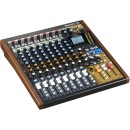
TASCAM Model 12 |
VS | ||
|---|---|---|---|
| Desktop | Form Factor | Desktop | Desktop |
| 12 (10 Inputs + Stereo Mix) | Number of Tracks | 16 |
WAV: 8 |
| 10x Recording | Maximum Simultaneous Tracks | 14x Recording | 8x Recording / 16x Playback (at 44.1 kHz) |
| 48 kHz / 24-Bit | Maximum Sampling Rate | 48 kHz / 24-Bit | 44.1 kHz / 24-Bit |
